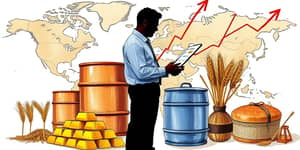Emerging markets present a blend of formidable risks and transformative opportunities that can shape diversified portfolios and drive long-term growth.
Defining Emerging Markets
Emerging markets are economies transitioning from developing status to advanced development, characterized by increasing global connectivity and reforms. These nations exhibit brisk recent economic growth closing the gap with mature economies, underpinned by rapid industrialization, institutional change, and export-led strategies.
Key examples include Brazil, China, India, Mexico, and South Africa—often referred to as the BRICS cohort. Other emerging groups, such as the MINT (Mexico, Indonesia, Nigeria, Turkey) and the Next Eleven, highlight the breadth of markets on the rise.
- Intermediate income levels and growth: PPP per capita at 10–75% of the EU average
- Institutional transformation underway: market liberalization and modern banking systems
- Export-led growth strategies: leveraging competitive labor for global trade
Current Market Performance
In Q2 2025, the MSCI Emerging Markets IMI Index delivered a robust +12.7% quarterly total return, outperforming both the MSCI World (+11.5%) and the S&P 500 (+10.9%). Year-to-date through mid-2025, the MSCI EM Index has gained +5.7%, albeit with significant dispersion—Poland is up +35% while Thailand lags at −12%.
Real GDP growth forecasts for EM in 2025 average 3.7%, more than double that of advanced economies, though slightly below the past decade’s 4% trend. EM inflation is expected to cool to roughly 5% from 8% in 2024, with exceptions such as Bolivia, Ghana, and Turkey facing double-digit pressures. China’s inflation has remained flat at 0% since 2023, reflecting unique domestic dynamics.
Opportunities in Emerging Markets
Emerging markets offer higher growth potential than developed economies, fueled by expanding consumer demand, rapid urbanization, and a rising middle class. Many nations are implementing structural reforms and fiscal discipline to underpin sustainable expansion.
- Consumer sector growth supported by demographic shifts
- Financial market deepening with increased liquidity and credit
- Sectors like infrastructure and clean energy benefiting from policy support
- Diversification benefits: EM equities and debt reduce portfolio correlation
Country-specific success stories underline these prospects. Poland’s +35% YTD equity performance reflects central bank stability and pro-investment policies, while Latin America’s resurgence is driven by commodity tailwinds and fiscal reform. Asia’s $8.5 trillion current account surpluses since 2010 have fueled capital redeployment into local equities and bonds, shifting away from traditional US Treasury exposure.
Pitfalls and Risks
Despite compelling upside, EM investing carries inherent risks. Price swings can be dramatic, driven by sharply volatile commodity price swings, currency fluctuations, and shifts in global monetary policy. Political events and regulatory changes can also erode investor confidence overnight.
- Market volatility from external shocks and policy shifts
- Geopolitical tensions, including tariff risks and trade disputes
- Inflation and currency depreciation leading to capital loss
- Governance concerns: weaker frameworks heighten fraud risk
- Country performance dispersion requires careful selection
Understanding structural fragilities—such as overdependence on commodity exports or uneven institutional progress—is key to navigating these pitfalls effectively.
Regional and Sector Variations
Emerging markets are far from homogeneous. Latin America and Central Europe currently outperform, while some Asian nations face headwinds due to soft export demand and political developments. Sectoral dynamics also vary.
Infrastructure demand is fueled by the need for modern ports, roads, and energy grids. Consumer technology benefits from rapid smartphone adoption and e-commerce growth. Clean energy investments in solar, wind, and affordable power solutions are gaining traction.
A nuanced view of each country and industry is essential to identify markets with strong long-term trajectories versus those prone to cyclical downturns.
Investment Flows and Strategy
Capital patterns are evolving. Asian economies, armed with $2.3 trillion in foreign reserves, are repatriating funds into local IPOs and growth opportunities. EM corporate earnings are anticipated to sustain double-digit earnings growth through 2026, opening avenues for dividend strategies and small-cap value plays.
Institutional investors are increasingly allocating to EM debt for yield enhancement, while active managers employ quality screens to mitigate governance risks. Understanding local regulatory regimes and developing relationships with seasoned on-the-ground teams can unlock superior risk-adjusted returns.
Future Outlook
Looking ahead, EM GDP growth is expected to remain above 3.5% through 2026, supported by ongoing reforms and digital adoption. Inflation challenges should gradually ease with monetary policy normalization, although country-specific risks—such as political elections and trade negotiations—will continue to drive volatility.
Investors who combine disciplined market analysis with strategic diversification can harness the transformational potential of these economies while mitigating downside. As global capital flows adjust to a multi-polar world, emerging markets will play an increasingly pivotal role in balanced, long-term portfolios.
References
- https://www.smartling.com/blog/emerging-markets
- https://www.vaneck.com/us/en/blogs/emerging-markets-equity/turning-tides-em-equities-are-surging-in-2025/
- https://en.wikipedia.org/wiki/Emerging_market
- https://www.triodos-im.com/articles/2025/emerging-markets-mid-year-2025-investment-outlook
- https://www.wisdomtree.com/investments/blog/2025/04/03/whats-hot-and-whats-not-in-emerging-markets-so-far-in-2025
- https://www.morganstanley.com/im/en-gb/intermediary-investor/insights/articles/opportunities-amid-us-slump.html
- https://www.robeco.com/en-int/insights/2025/06/why-emerging-markets-are-back-in-focus
- https://www.gam.com/en/our-thinking/investment-opinions/unlocking-opportunities-in-emerging-markets










